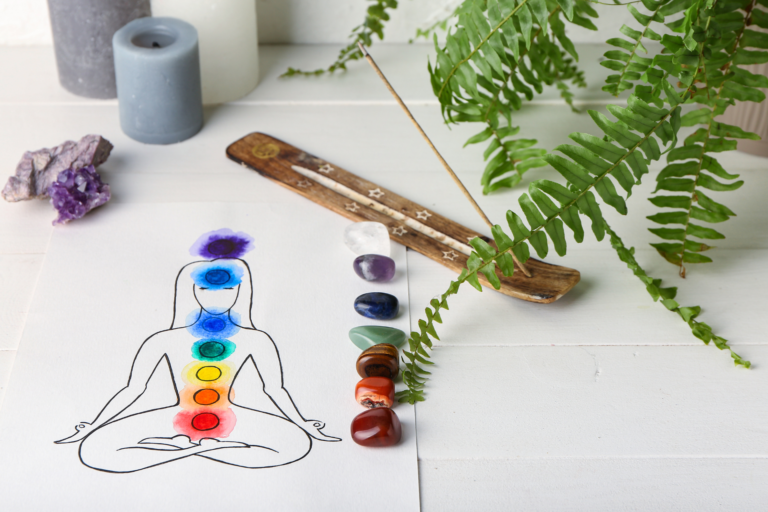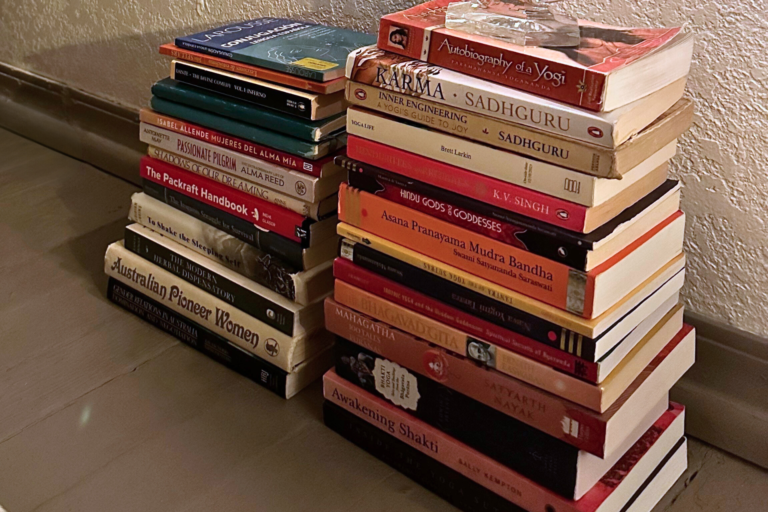Are your samskaras holding you back?
Sanskaras are psychological imprints that have taken over most of our lives. (ever heard of triggers??) Yoga helps us witness our samskaras and come back into our Truth.
I just got home from the Front Range Yoga Fest up in Choteau, where samskaras came up in one of the lectures. Coincidentally, my good friend Diego, a fellow yogi and overthinker, mentioned his samskaras and his struggle to release them.
Naturally, this got me thinking about my samskaras the whole drive home and how they are influencing my reality.
Because yoga is a practice both on and off the mat, I wanted to share my exploration of samskaras here with you.
What are samskaras?
Samskaras are basically mental impressions or habits that shape our thoughts, behaviors, and reactions. Think of them like grooves or patterns etched into our minds by our past experiences and actions. Every experience we go through, every action we take, leaves a little mark on our subconscious mind. These marks are samskaras.
Over time, they build up and influence how we perceive the world and how we respond to it. It’s like if you walk the same path in a field over and over again, eventually you’ll create a clear trail. Similarly, our repeated thoughts and actions create mental trails – samskaras – in our minds.
These well-worn pathways are so ingrained in our minds that Sutra 1.18, of Yoga Sutras of Patanjali, mentions that even in deep meditation, these impressions are still present.
Sutra 2.11 explains that the subtle forms of these impressions can be destroyed by meditation.
I really like the lake analogy shared in Tantra Of The Yoga Sutras. There is a greater Truth out there that explains the Big Picture. Broadly speaking, Yogic philosophy says that humans are just the Universe experiencing itself. Energy catapulted through the ethers can be transformed and transmuted in this cosmic dance that allows the Powers of the Universe to basically witness and experience itself.
So the greater Truth is that… not the drama in our minds.
Just like you can clearly see the details at the bottom of a lake with crystal clear, still water, so too can we clearly see the Truth when our minds are clear and still. Meditation is meant to help with that. And the asanas in our daily yoga practice help us get to meditation.
Want to study samskaras with me? These are the two books I refer to when studying the Yoga Sutras:
Oh, and these are affiliate links, which means I make a commission from any purchases you make at no cost to you. Because, you know, business. You can read my Commission Disclosure here.
So what exactly are samskaras and how do we get them?
Our samskaras are impressions that we identify as truth. Those impressions can come from life experiences, societal and cultural influences, and family dynamics. In psychological terms, these would be learned behaviors, “triggers”, and attachment styles.
In the Yoga Sutras, Sutra 4.9 says that even our past lives can bring in samskaras that we carry for all of eternity until one of us in this endless string of lives clears them out.
Samskaras play a big role in shaping the fluctuations of our chitta – the mind. Coming back to the lake analogy, chitta is the whole lake. Yoga and meditation clear vritti, the ripples on the surface of the lake that make it difficult to see the Truth at the bottom of the lake.
Taking disciplined action, tapas, is how we begin to clear negative samskaras and instill positive patterns.
So what kinds of actions are we talking about?
Actions that help create an environment in which positive samskaras can create new pathways and habits include meditation, yoga, and practicing the Yamas and Niyamas, the first two limbs of the eight limbs of yoga. (Read my blog post about the eight limbs of yoga if you want to get a quick overview.)
Changing behavior that is not aligned with our vision of a peaceful life is the other major part of clearing samskaras. Things like impulsive reactions and dwelling in victimhood by allowing yourself to be triggered by other people or life circumstances are the vasanas that we need to actively witness and release. To clear our negative samskaras, or unhealthy behavior patterns, we need to replace them with healthier behavior. This includes:
- practicing clear communication
- healthy boundaries
- respect and compassion for others,
- disciplined action (tapas) around self-care and your yoga practice
Karma is the cycle of action and reaction. Every action we take creates or clears a samskara, which then influences our future actions. With tapas, or disciplined action, we can settle our minds enough to see the Truth shining at the bottom of the lake, bringing more balance and harmony into our lives.

How our samskaras influence our reality
First, let’s get clear about the difference between reality and Truth. Our reality is this worldly stuff: the stress, the drama, the attachments. The Truth is that none of that matters because there is a much bigger cosmic thing happening.
So how does that show up in our lives, creating a reality that is distracting us from Truth?
Think about a time when you’ve reacted negatively in a stressful situation. Maybe you snapped at someone or felt overwhelmed. These reactions are influenced by samskaras formed from past experiences where stress was handled poorly.
If, for example, you often witnessed arguments at home as a child or even didn’t witness any conflict at all, you might have developed samskaras that predispose you to react with anger or anxiety when difficult situations come up.
Or consider someone who grew up in a supportive and loving environment. They might have samskaras of feeling valued and confident, which influence their thoughts and behaviors in a positive way. They tend to approach challenges with a sense of assurance and are more likely to pursue their goals without self-doubt.
On the other hand, someone who faced constant criticism might have samskaras of self-doubt and insecurity. This can lead to behaviors like avoiding new opportunities or fearing failure, as their past experiences have created deep grooves of negativity in their mind.
You see how it becomes our responsibility to clear these samskaras and unlearn these patterns??
In this sense, yoga and meditation become essential to a life worth living.
Transforming samskaras through Yoga
Often, these mental impressions operate below our conscious awareness, subtly influencing our actions and reactions. By cultivating mindfulness, we can start to notice these patterns as they arise, giving us the opportunity to choose different responses and create new, positive samskaras. This heightened awareness allows us to break free from old habits and behaviors that no longer serve us.
Here are some actionable yoga techniques for transforming negative samskaras:
Meditation and mindfulness
Like the Yoga Sutras point out, regular meditation helps bring awareness to our thoughts and emotions, allowing us to observe our samskaras without judgment. While many people think they can’t meditate because their minds are never quiet, that’s exactly the point of meditation. It’s meant to give you space to observe your thoughts, not try to end them. Watch what comes up and be curious about it.
Begin to notice any patterns. For instance:
- Are you harshly criticizing yourself regularly?
- Or having imaginary conversations where you justify your actions or likes/dislikes?
- Do your thoughts consistently come back to a single stressor?
This isn’t to give you more to think about. In fact, the Yoga Sutras say that you will have reached Samadhi (enlightenment… the entire end goal of Yoga) when you are doing nothing at all, not even during meditation. You simply are and no worldly distractions can take you out of this state. But this is after lifetimes of practicing yoga and meditation.
So for now, let the thoughts bubble up to the mind’s surface. When you notice that you’re distracted, take a long, slow, deep breath and observe your body’s every subtle movement throughout this breath. Repeat this again and again until you realize that you’re distracted again.
You can bring that same mindfulness to everything you do throughout the day. Practices like mindfulness meditation teach us to stay present and recognize when old patterns emerge, creating space for new, healthier responses.
Pranayama (breath control) exercises
Breath control exercises like Nadi Shodhana (Alternate Nostril Breathing) and Bhramari (Humming Bee Breath) can help calm the mind and balance the nervous system. There is so much research about yogic breathing and the manyyyyyyy benefits.
These practices create a sense of inner peace, making it easier to transform negative samskaras into positive ones. For instance, not blowing up at someone by accident or being offended by a stranger. It is knowing, instead, that most people are acting out their own samskaras and not seeing from a place of Truth.
Asanas (physical postures) for mental clarity and balance
Certain yoga postures can support mental clarity and emotional balance. For example:
- Balasana (Child’s Pose): Promotes relaxation and grounding, helping to release stress and anxiety.
- Sukhasana (Easy Pose) with forward bend: Enhances focus and introspection.
- Virabhadrasana II (Warrior II): Builds confidence and strength, countering feelings of insecurity.
Give my Hatha yoga class a try, where I guide you through postures for your seven chakras:
Personal reflection and journaling
Taking time to reflect on your experiences and writing about them can bring unconscious samskaras to light. Journaling about your thoughts, feelings, and reactions helps you identify recurring patterns and understand their origins.
Writing about your cognitions and relating them to your emotions can help you develop greater awareness and see the silver lining in a stressful situation (here’s the study).
By incorporating these yoga techniques into your routine, you can begin to transform negative samskaras, fostering a more balanced and harmonious mental state.
Ready to clear your samskaras?
I created this Samskara Self Exploration Workbook to help you identify your samskaras and a practice to clear them. If you’re already a paying member of my newsletter, then you can access this workbook already!








